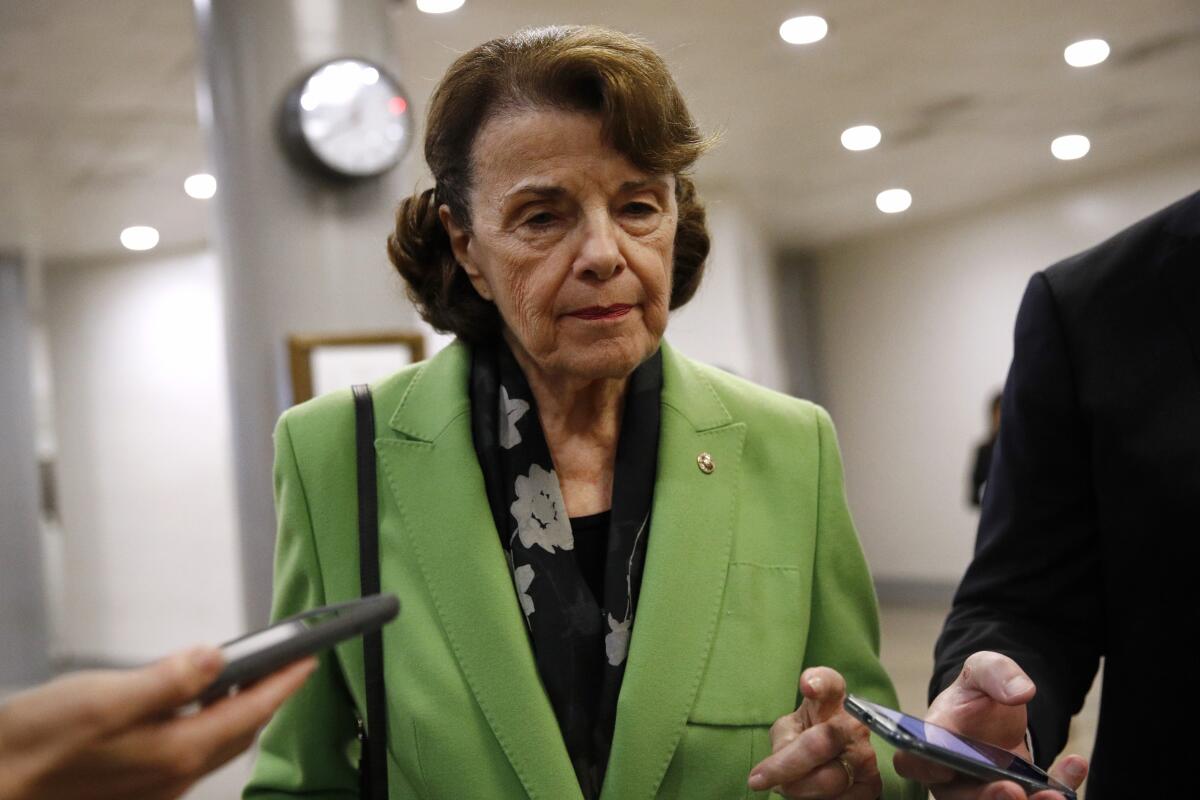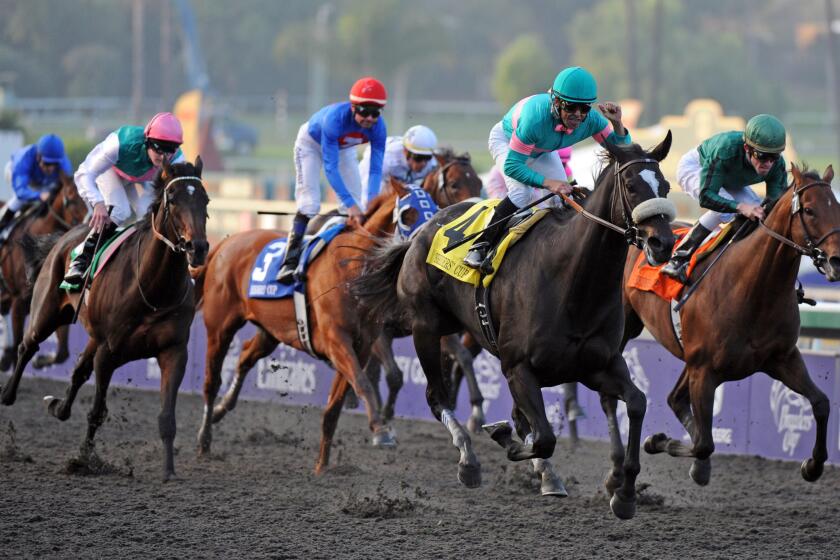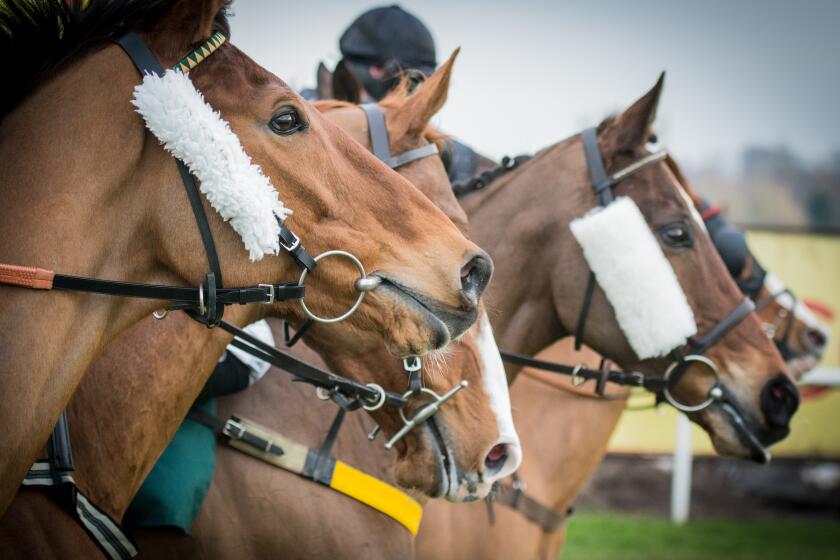Sen. Dianne Feinstein calls Breeders’ Cup ‘a critical test for the future of horse racing’

At a time when horse racing is usually celebrating its current and future stars, instead it is collectively holding its breath, fingers crossed, hoping that every horse that starts a race also finishes it.
The Breeders’ Cup has returned to Santa Anita for a record 10th time. There will be 14 races over Friday and Saturday worth in excess of $30 million in purses. But the numbers that seem to matter most are those of horse fatalities the track has endured since Dec. 30 of last year. Thirty-six horses have died, six during this abbreviated six-week meeting which ends Sunday.
The Breeders’ Cup format has five races on Friday, all involving 2-year-olds in pretty much every combination of male and female horses, dirt and turf and sprint and distance. The most anticipated race is the $2 million Juvenile, from where the early Kentucky Derby favorite could emerge.
On Saturday, there are nine races, culminating in the $6 million Classic, which is considered the end of the year championship for all horses that can run 1 ¼ miles.
The need for safe racing was escalated on Wednesday when Sen. Dianne Feinstein (D-Calif.) issued a challenge to the California Horse Racing Board that there had better not be any deaths or there may be consequences.
“I believe this weekend presents a critical test for the future of horse racing in California and in the United States,” Feinstein wrote to Rick Baedeker, executive director of the CHRB. “If horse racing can not be conducted in a safe , and humane manner that protects the life and safety of horses and jockeys, it may be time to reexamine the future of this sport in our state and in our country.”
Ten years have passed since Zenyatta’s amazing victory at the Breeders’ Cup, but the memories remain as vivid as ever for the fans who witnessed it.
Feinstein called the six deaths this meeting “simply unacceptable.”
Horses in the Breeders’ Cup will be given an unprecedented amount of scrutiny.
“No horses racing anywhere have been more examined or more observed than these horses,” said Dr. Deborah Lamparter, who heads the Breeders’ Cup veterinary team. “We will watch them from the receiving barn to the paddock to the post to the gate and to the wire. And, of course, after the race on the way off [to the barn].”
All horses, including those on the non-Breeders’ Cup card, will be examined three or four times before race day and will be observed multiple times on race day.
There will be 30 veterinarians on-site race day, up from the 20 that have been in the barns all week. All horses have been tested for illegal drugs. There were no positive tests. In addition, there are 15 equine investigators, paired with 12 investigators from the CHRB. There are 140 security officers who will monitor and note every time someone goes into a stall. Santa Anita has 1,100 cameras that cover every shedrow and almost every place a horse may step on the backstretch.
Almost to a person, both trainers who stable at Santa Anita to those who have shipped in from the rest of the country and world have expressed confidence in the track.
“We’ve had some bad luck here, whatever it is,” said Hall of Fame trainer Richard Mandella. “It’s like there is this cloud over us. [I know] that seems like an easy out. The most important thing is everyone in this game has to concentrate on safety. We’ve got to get through this hump.
“Oftentimes trying too hard is as big of a problem as not trying. Maybe we’ve got a little bit of that going on. Who knows? But there is no lack of effort.”
Experts are concerned the use of bisphosphonates in thoroughbreds will lead to more breakdowns and serious injuries — and the drugs can’t be traced.
The Breeders’ Cup has been around for 34 years and during that time has had 12 racing fatalities and one paddock accident that resulted in death. Using the metrics devised by The Jockey Club’s equine injury database, which counts deaths per 1,000 starts, the Breeders’ Cup has a rating of 3.1. The national average last year was 1.68.
However, the Breeders’ Cup has improved as has the national average over time. Over the last 10 years, the rating was 1.8 and 1.2 over the last five years. Santa Anita, which has hosted nine times, has a rating of 1.7, equal to last year’s national average. The most dangerous race, with four of the fatalities, is the Distaff, which has an EID rating of 12.3. Of the races that have been around since the start, there has never been a fatality in the Juvenile or Turf.
Despite all the reforms as far as medication and veterinarian oversight, Santa Anita has had two more deaths in this abbreviated six-week meeting than it did during the entire fall meeting last year when there was less scrutiny.
Dr. Dionne Benson, chief veterinary officer for the Stronach Group, would not speculate as to why this has occurred.
“Until the full investigation will be done, and the information from necropsies is back, it is premature for us to comment,” Benson said. “For our purposes we will continue to try to see what, if anything, can be done and what can be improved in horse safety and welfare. And if we identify anything we will make those changes.”
For the industry’s survival it will have to drive discussion away from body counts and back onto the racing. It’s counting on Friday and Saturday to be a start.
More to Read
Go beyond the scoreboard
Get the latest on L.A.'s teams in the daily Sports Report newsletter.
You may occasionally receive promotional content from the Los Angeles Times.












